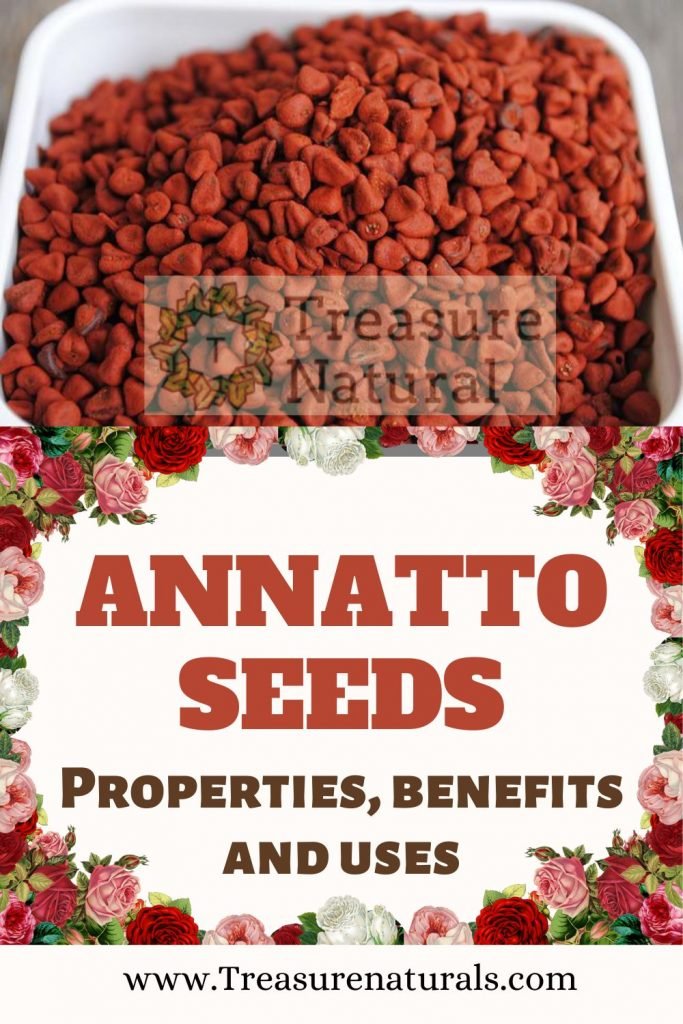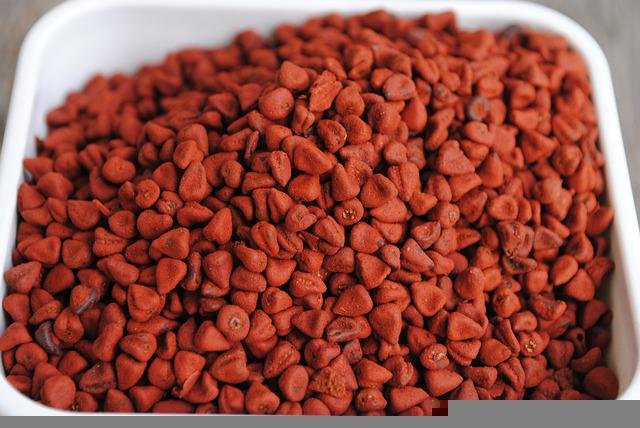
Annatto is the name of a very popular spice in Asia and South America. It is obtained from the seeds of achiote, a typical plant of the Amazon. In the West, this spice is not well known for its properties, but only as an E160b dye.
Annatto seeds: natural coloring
Its seeds are small, reddish and irregular in shape. They are obtained from the Achiote plant (Bixa orellana), a shrub that belongs to the Bixaceae family and is native to South America. Today the largest exporter of this spice is Brazil.
The seeds of a yellow-red color are extracted from the akiote caused by the high quantity of carotene contained: with these seeds a natural dye is produced, cataloged as E160b.
Characteristics of the achiote plant
The plant is a shrub with:
- heart-shaped oval leaves.
- flowers with 5 pinkish white petals and a lilac center. Flowering occurs between July and January depending on the area in which it is grown. The flowers can be white, white-pink and pink-purple.
- fruits (pods) red with a yellow interior, covered with a red down, arranged in clusters. When the fruit is ripe, it splits in half and has about 50 seeds inside. The fruits are collected and macerated in water while the seeds are dried.
- seeds small and brick-red in color, trapezoidal in shape, slightly pointed on one side, 4 mm long and 3 mm wide.
Origin of the plant
It comes from the Caribbean Islands, Central America and the western part of South America. Today it is produced and exported mainly from Brazil and Peru.
The seeds are used as a dye in cooking and as a spice in Mexico and South America, the Philippines, the Caribbean, China and Vietnam. In many other tropical countries, however, it is only an ornamental plant.
Healing properties of annatto seeds
There are many healing properties of the achiote plant:
- helps to lose weight by being a natural diuretic.
- it is a laxative for its active ingredients such as fibers and pectin, which stimulate intestinal peristalsis, favoring the elimination of toxins and waste.
- counteracts dysentery, fever and kidney diseases, in alternative medicine
- is a natural antioxidant: it contains carotenoids which act as antioxidants and improve fat burning.
The active ingredients in annatto seeds
The main active ingredients present in the plant are the carotenoids among which the main one is bixin, which can reach up to 7% of the mass of the seed and is responsible for its red color.
In the seeds are bixin, norbixin and cisbixin. All coloring carotenoids.
The seeds are first dried and then ground to obtain a powder that is easy to use in the kitchen.
The characteristic that makes it useful in both the culinary and textile fields is certainly the brick red color that it gives to foods and fabrics, as well as having a pleasant aroma and scent similar to nutmeg.
How and where to buy annatto
Only the seeds are used and can be found on the market both whole and in powder, and in oily paste, especially in Mexico.
If the seeds are purchased online, it is necessary to check that they are whole, brick-colored and fragrant: only in this way are they good and well preserved.
How to use annatto
They are used to color fabrics in a natural way of a beautiful brick red. From the seeds immersed in boiling water and left for the time necessary to give color to the water, the dye passes to the fabric.
The seeds and the powder should be stored in a container away from light.
Annatto: use in the kitchen
Seeds are one of the spices used in cooking to flavor dishes and to give a reddish color to the dish or dessert.
The water where the seeds are boiled, which causes them to lose their color, can then be used to cook vegetables, meat or rice.
In Central and South America it is mainly used as a dye. In particular
- in the Caribbean the seeds are fried with oil or other animal fat and the colored condiment obtained is used to cook meats and vegetables.
- in Mexico, seed paste mixed with vinegar is used to marinate meat.
- in the Philippines, the seeds are ground and added to soups.
- in Vietnam, it is used to color soups, curry or duck lacquer.
- in the West it is rarely used, only as a natural food coloring
It has a slightly spicy taste and is admitted by the European Union as a colorant, with the name of E160b, for smoked fish, margarine, some cheeses such as cheddar. In the past it was also used to color lower quality butter, making it acquire a delicate yellow color, typical of pasture butter.
How to prepare annatto oil
To prepare the annatto oil, take 1/2 cup of olive oil, add 2 tablespoons of seeds and heat for 5 minutes. The oil turns reddish yellow and can be used on potatoes, in salads to dress rice.
Annatto in cosmetics
Because of its beautiful red color it is used in cosmetics for makeup products such as lipsticks, or as a hair dye. The latter use is in particular a typical custom of some Indios populations of Ecuador.
It is also used in the production of toothpaste, in emulsions and in soap to give an orange color.
There are no contraindications to normal doses except in cases of individual hypersensitivity.
Annatto: roucou oil for hair
Roucou oil is also called hair whisper due to its high ability to protect hair from UV rays. Little known despite its many properties, it too derives like annatto, from the anchiote plant.
Its main properties:
- protection of the hair from the sun and UV rays
- antibacterial and antiseptic properties, important for the scalp.
- stimulates the production of melanin and removes the appearance of white hair
- anti-frizz and nourishing properties for the most unruly hair
- it also counteracts the effects of the heat of the hairdryer and is used for the production of shampoos, shaping hair cream, anti-frizz products.
- prevents aging and maintains skin elasticity.
- neutralizes free radicals thanks to ellagic acid
Alternative uses
Helps prevent mosquito and wasp bites and is a natural repellent.
In sweet medicine, the seeds were used against dysentery, fever and diseases of the kidneys. It is used to color ointments and ointments
Annatto and food safety
Annatto used as a coloring agent in many everyday foods (cheeses, sweets, popsicles, snacks for children …) to ensure that the quantity of bixin and norbixin contained is not harmful to humans.
Even today it is not possible to give certainty about the food safety of this dye. For this EFSA has allowed the use of:
- 6 mg of bixin for every kg of body weight per day
- 0.3 mg of norbixine for every kg of body weight per day
And he advised against its use for children, because it could cause allergy.
Curiosities about the annatto

The Aztecs used the seeds as a body dye for ceremonies and rituals. Some tribes of Indians use it to dye their hair (red men).
In India they use the pod is an insect repellent.
In many Hindu communities it is known as a sindoor and is considered a good omen for weddings. Applied in the middle of the forehead near the hairline it indicates that the woman is married.






